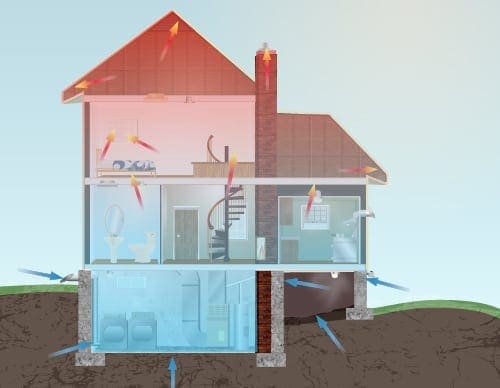Building Homes to Meet Blower Door Requirements

The 2012/2015 IECC Prescriptive Air Infiltration (Blower Door) requirement is here to stay, but adopting the code doesn’t have to be painful.

Buyers of new homes expect their houses to be energy-efficient and comfortable, while also decreasing their costs on utility bills. We've never met a builder that doesn't claim they deliver on that promise. But how do you know how a house will perform if you do not measure the items which affect performance and comfort?
While the 2012/2015 IECC Prescriptive Air Infiltration (Blower Door) requirement can help solve this, they also may present compliance difficulties for builders. Good news though, it doesn't have to be painful!
Why Air Infiltration Matters
Undoubtedly, it costs money to heat and cool a home. Once we have paid to have the air heated or cooled, it makes sense to try to keep it inside the home, right?
Building Science tells us that heat moving with air through unsealed cracks, holes, and other openings is a much more significant source of heat loss (or gain) in a home than heat transfer through a solid wall or roof assembly.
This heat loss does not matter if it is up, down, left, or right; all there needs to be is an escape path, and since air is pretty small, it can get through the tiniest of openings. To make the problem even worse, fibrous insulation (fiberglass) does little to slow this heat loss because the air carrying the heat can move through the insulation faster than the insulation can do its job.
Therefore, the holes between the inside of the house and the outside of the house need to be sealed with a material that will stop air movement. Stuffing fiberglass into a hole is not going to eliminate the problem.
A blower door test provides a quantifiable measure of how airtight a house is.

Would you want to pay the energy bill for this house? No! It's leaky. All of the conditioned air would just escape! Air sealing helps ensure that homes keep the conditioned air in.
Most Common Air Infiltration Problems
 Our experience performing thousands of blower door tests has shown the most common issues for low performing results:
Our experience performing thousands of blower door tests has shown the most common issues for low performing results:
- Foundation to the sill plate
- Rim and box joists
- The gap between framing and shaft liner walls
- Poorly sealed penetrations between ceiling and attic such as canned lights and bath fans
- Poorly sealed mechanical penetrations
Installing mechanical systems in garages and attics is like coming to the plate with 2 ¾ strikes against you, and architects need to be aware of this.
We have also discovered some surprising places where air can get into a house, such as poorly backfilled crawl spaces where air can travel through gravel and perimeter drains or through unsealed sump pits.
Adopting the 2012/2015 IECC Prescriptive Air Infiltration (Blower Door) Code
Building homes to meet the 2012/2015 IECC Prescriptive Air Infiltration (Blower Door) requirement is here to stay, but adopting the code doesn’t have to be painful.
We believe the requirement helps to build a higher-performing home, making your clients happier and more comfortable, which may lead to fewer warranty calls.
EnergyLogic is an experienced consultant, positioned to help you understand why blower door tests are important and to help you to meet energy code requirements, while delivering a better product to your customers.
If you have any questions or would like to request a service quote, please contact contact us.
We believe the 2012/2015 IECC Prescriptive Air Infiltration (Blower Door) requirement helps:
- Create a higher-performing home
- Make your clients happier and more comfortable
- Reduce warranty calls




